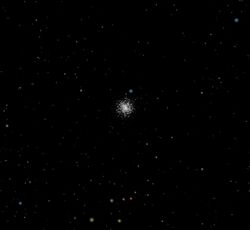Astronomy:NGC 4372
From HandWiki
Short description: Globular cluster in the constellation Musca
| NGC 4372 | |
|---|---|
 | |
| Observation data (J2000 epoch) | |
| Class | XII[1] |
| Constellation | Musca |
| Right ascension | 12h 25m 45.43s[2] |
| Declination | −72° 39′ 32.7″[2] |
| Distance | 18.9 kly (5.8 kpc)[3] |
| Apparent magnitude (V) | 9.85[2] |
| Apparent dimensions (V) | 18' |
| Physical characteristics | |
| Absolute magnitude | -8.52 |
| Mass | 3.29×105[3] M☉ |
| Radius | 49.5 ly |
| Metallicity | [math]\displaystyle{ \begin{smallmatrix}\left[\ce{Fe}/\ce{H}\right]\end{smallmatrix} }[/math] = –2.33±0.08[4] dex |
| Estimated age | 12.54 Gyr[5] |
| Other designations | Caldwell 108 |
NGC 4372 (also known as Caldwell 108) is a globular cluster in the southern constellation of Musca. It is southwest of γ Muscae (Gamma Muscae) and west of the southern end of the Dark Doodad Nebula (Sandqvist 149), a 3° thin streak of black across a southern section of the great plane of the Milky Way.
NGC 4372 "is partially obscured by dust lanes, but still appears as a large object some 10 arcseconds in diameter," according to Astronomy of the Milky Way (2004).[6]
The cluster has highly peculiar chemistry similar to NGC 5694, being extremely iron-poor yet having super-solar abundances of magnesium and titanium.[4]
References
- ↑ Shapley, Harlow; Sawyer, Helen B. (August 1927), "A Classification of Globular Clusters", Harvard College Observatory Bulletin 849 (849): 11–14, Bibcode: 1927BHarO.849...11S.
- ↑ 2.0 2.1 2.2 "NGC 4372". SIMBAD. Centre de données astronomiques de Strasbourg. http://simbad.u-strasbg.fr/simbad/sim-basic?Ident=NGC+4372.
- ↑ 3.0 3.1 Boyles, J. et al. (November 2011), "Young Radio Pulsars in Galactic Globular Clusters", The Astrophysical Journal 742 (1): 51, doi:10.1088/0004-637X/742/1/51, Bibcode: 2011ApJ...742...51B.
- ↑ 4.0 4.1 Kovalev, Mikhail; Bergemann, Maria; Ting, Yuan-Sen; Rix, Hans-Walter (2019), "Non-LTE chemical abundances in Galactic open and globular clusters", Astronomy & Astrophysics 628: A54, doi:10.1051/0004-6361/201935861
- ↑ Forbes, Duncan A.; Bridges, Terry (May 2010), "Accreted versus in situ Milky Way globular clusters", Monthly Notices of the Royal Astronomical Society 404 (3): 1203–1214, doi:10.1111/j.1365-2966.2010.16373.x, Bibcode: 2010MNRAS.404.1203F.
- ↑ Inglis, Mike (2004). Astronomy of the Milky Way: Observer's Guide to the Southern Sky. Springer. p. 83. ISBN 1852337427. https://books.google.com/books?id=1r0qvMjSCGAC&pg=SA3-PA12.
External links
- NGC 4372 at Wikisky
- NGC 4372 at Astrosurf
- NGC 4372 on WikiSky: DSS2, SDSS, GALEX, IRAS, Hydrogen α, X-Ray, Astrophoto, Sky Map, Articles and images
- NASA Astronomy Picture of the Day: NGC 4372 and the Dark Doodad (31 January 2013)
Coordinates: ![]() 12h 26m 00s, −72° 40′ 00″
12h 26m 00s, −72° 40′ 00″
 |

